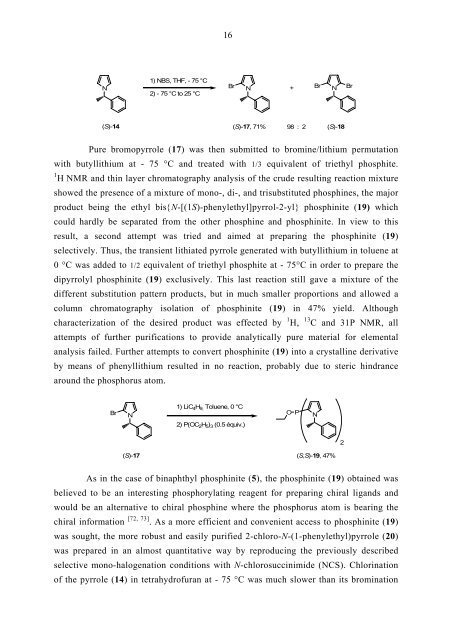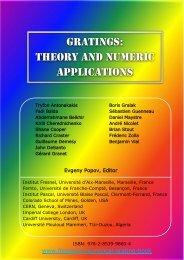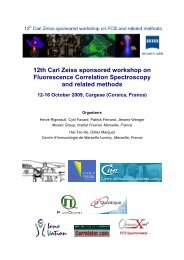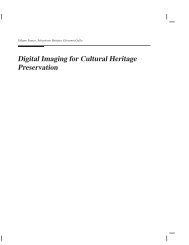My PhD dissertation - Institut Fresnel
My PhD dissertation - Institut Fresnel
My PhD dissertation - Institut Fresnel
Create successful ePaper yourself
Turn your PDF publications into a flip-book with our unique Google optimized e-Paper software.
N<br />
(S)-14<br />
1) NBS, THF, - 75 °C<br />
2) - 75 °C to 25 °C<br />
16<br />
Br<br />
N N Br<br />
+ Br<br />
(S)-17, 71% 98 : 2 (S)-18<br />
Pure bromopyrrole (17) was then submitted to bromine/lithium permutation<br />
with butyllithium at - 75 °C and treated with 1/3 equivalent of triethyl phosphite.<br />
1 H NMR and thin layer chromatography analysis of the crude resulting reaction mixture<br />
showed the presence of a mixture of mono-, di-, and trisubstituted phosphines, the major<br />
product being the ethyl bis{N-[(1S)-phenylethyl]pyrrol-2-yl} phosphinite (19) which<br />
could hardly be separated from the other phosphine and phosphinite. In view to this<br />
result, a second attempt was tried and aimed at preparing the phosphinite (19)<br />
selectively. Thus, the transient lithiated pyrrole generated with butyllithium in toluene at<br />
0 °C was added to 1/2 equivalent of triethyl phosphite at - 75°C in order to prepare the<br />
dipyrrolyl phosphinite (19) exclusively. This last reaction still gave a mixture of the<br />
different substitution pattern products, but in much smaller proportions and allowed a<br />
column chromatography isolation of phosphinite (19) in 47% yield. Although<br />
characterization of the desired product was effected by 1 H, 13 C and 31P NMR, all<br />
attempts of further purifications to provide analytically pure material for elemental<br />
analysis failed. Further attempts to convert phosphinite (19) into a crystalline derivative<br />
by means of phenyllithium resulted in no reaction, probably due to steric hindrance<br />
around the phosphorus atom.<br />
Br<br />
N<br />
(S)-17<br />
1) LiC 4H 9, Toluene, 0 °C<br />
2) P(OC 2H 5) 3 (0.5 équiv.)<br />
O P<br />
N<br />
(S,S)-19, 47%<br />
As in the case of binaphthyl phosphinite (5), the phosphinite (19) obtained was<br />
believed to be an interesting phosphorylating reagent for preparing chiral ligands and<br />
would be an alternative to chiral phosphine where the phosphorus atom is bearing the<br />
chiral information [72, 73] . As a more efficient and convenient access to phosphinite (19)<br />
was sought, the more robust and easily purified 2-chloro-N-(1-phenylethyl)pyrrole (20)<br />
was prepared in an almost quantitative way by reproducing the previously described<br />
selective mono-halogenation conditions with N-chlorosuccinimide (NCS). Chlorination<br />
of the pyrrole (14) in tetrahydrofuran at - 75 °C was much slower than its bromination<br />
2













